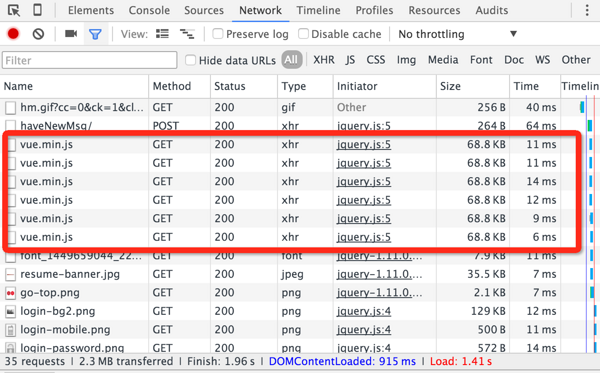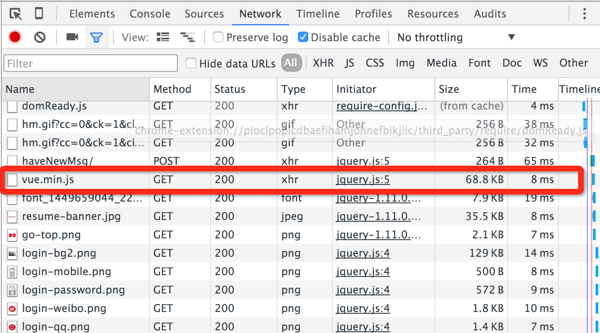Detailed explanation of js asynchronous file loader
We often encounter this scenario. Some pages rely on third-party plug-ins, and these plug-ins are relatively large and are not suitable for packaging into the main js of the page (assuming we are using the cmd method, the js will be packaged into a file), then at this time we usually obtain these plug-in files asynchronously and complete the initialization logic after the download is completed.
Take image upload as an example, we may use the plupload.js plug-in, then we will write like this:
!window.plupload ?
$.getScript( "/assets/plupload/plupload.full.min.js", function() {
self._initUploader();
}) :
self._initUploader();But our pages usually consist of multiple independent modules (components) Composition, if both modules A and B on the page depend on plupload.js, do you need to write the above code in both places? If you do this, two requests may be initiated before plupload.js is downloaded. Since it is downloaded in parallel, the js file may be downloaded repeatedly instead of downloading it for the first time and fetching the cached content the second time.
The following picture shows the situation where multiple components of the page depend on vue.js (scenario where jquery and vue are mixed):

So, in actual use, it is necessary Locking means that when the script is loading, the script should not be requested repeatedly. After the loading is completed, the following logic will be executed in sequence. With the good tool of promise, it is very simple to implement.
// vue加载器
var promiseStack = [];
function loadvue() {
var promise = $.Deferred();
if (loadvue.lock) {
promiseStack.push(promise);
} else {
loadvue.lock = true;
window.Vue ?
promise.resolve() : // 这里写错了,window.Vue为true的时候lock要置为false,我在后面改过来了
$.getScript( "/assets/vue/vue.min.js", function() {
loadvue.lock = false;
promise.resolve();
promiseStack.forEach(function(prom) {
prom.resolve();
});
});
}
return promise;
}
window.loadvue = loadvue;Then depend on vue.js:
loadvue().then(function() { // do something });Look at the request again:

Okay, the problem seems to be solved here , but if there are multiple plug-in dependencies on my page, such as relying on both plupload.js and vue.js, do I have to write the above code again (why do I feel like I have said this)? Wouldn't this be redundant? So we need an asynchronous loader generator that can help us generate multiple asynchronous loaders.
/**
* @des: js异步加载器生产器
* @param {string} name 加载器名称
* @param {string} global 全局变量
* @param {string} url 加载地址
**/
var promiseStack = {};
exports.generate = function(name, global, url) {
var foo = function() {
if (!promiseStack[name]) {
promiseStack[name] = [];
}
var promise = $.Deferred();
if (foo.lock) {
promiseStack[name].push(promise);
} else {
foo.lock = true;
if (window[global]) {
foo.lock = false;
promise.resolve();
} else {
$.getScript(url, function() {
foo.lock = false;
promise.resolve();
promiseStack[name].forEach(function(prom) {
prom.resolve();
});
});
}
}
return promise;
};
return foo;
};Then we can generate an asynchronous loader and assign it to window
// 全局加载器 window.loadvue = loader.generate( 'vue', 'Vue', '/assets/vue/vue.min.js'); window.loadPlupload = loader.generate( 'plupload', 'plupload', '/assets/plupload/plupload.full.min.js');
The same as above when used, which basically solves our problem.
The above are the details about the js asynchronous file loader. I hope it will be helpful to everyone's learning.
For more detailed articles related to js asynchronous file loader, please pay attention to the PHP Chinese website!

Hot AI Tools

Undresser.AI Undress
AI-powered app for creating realistic nude photos

AI Clothes Remover
Online AI tool for removing clothes from photos.

Undress AI Tool
Undress images for free

Clothoff.io
AI clothes remover

Video Face Swap
Swap faces in any video effortlessly with our completely free AI face swap tool!

Hot Article

Hot Tools

Notepad++7.3.1
Easy-to-use and free code editor

SublimeText3 Chinese version
Chinese version, very easy to use

Zend Studio 13.0.1
Powerful PHP integrated development environment

Dreamweaver CS6
Visual web development tools

SublimeText3 Mac version
God-level code editing software (SublimeText3)

Hot Topics
 1664
1664
 14
14
 1422
1422
 52
52
 1316
1316
 25
25
 1268
1268
 29
29
 1242
1242
 24
24
 Demystifying JavaScript: What It Does and Why It Matters
Apr 09, 2025 am 12:07 AM
Demystifying JavaScript: What It Does and Why It Matters
Apr 09, 2025 am 12:07 AM
JavaScript is the cornerstone of modern web development, and its main functions include event-driven programming, dynamic content generation and asynchronous programming. 1) Event-driven programming allows web pages to change dynamically according to user operations. 2) Dynamic content generation allows page content to be adjusted according to conditions. 3) Asynchronous programming ensures that the user interface is not blocked. JavaScript is widely used in web interaction, single-page application and server-side development, greatly improving the flexibility of user experience and cross-platform development.
 The Evolution of JavaScript: Current Trends and Future Prospects
Apr 10, 2025 am 09:33 AM
The Evolution of JavaScript: Current Trends and Future Prospects
Apr 10, 2025 am 09:33 AM
The latest trends in JavaScript include the rise of TypeScript, the popularity of modern frameworks and libraries, and the application of WebAssembly. Future prospects cover more powerful type systems, the development of server-side JavaScript, the expansion of artificial intelligence and machine learning, and the potential of IoT and edge computing.
 JavaScript Engines: Comparing Implementations
Apr 13, 2025 am 12:05 AM
JavaScript Engines: Comparing Implementations
Apr 13, 2025 am 12:05 AM
Different JavaScript engines have different effects when parsing and executing JavaScript code, because the implementation principles and optimization strategies of each engine differ. 1. Lexical analysis: convert source code into lexical unit. 2. Grammar analysis: Generate an abstract syntax tree. 3. Optimization and compilation: Generate machine code through the JIT compiler. 4. Execute: Run the machine code. V8 engine optimizes through instant compilation and hidden class, SpiderMonkey uses a type inference system, resulting in different performance performance on the same code.
 Python vs. JavaScript: The Learning Curve and Ease of Use
Apr 16, 2025 am 12:12 AM
Python vs. JavaScript: The Learning Curve and Ease of Use
Apr 16, 2025 am 12:12 AM
Python is more suitable for beginners, with a smooth learning curve and concise syntax; JavaScript is suitable for front-end development, with a steep learning curve and flexible syntax. 1. Python syntax is intuitive and suitable for data science and back-end development. 2. JavaScript is flexible and widely used in front-end and server-side programming.
 JavaScript: Exploring the Versatility of a Web Language
Apr 11, 2025 am 12:01 AM
JavaScript: Exploring the Versatility of a Web Language
Apr 11, 2025 am 12:01 AM
JavaScript is the core language of modern web development and is widely used for its diversity and flexibility. 1) Front-end development: build dynamic web pages and single-page applications through DOM operations and modern frameworks (such as React, Vue.js, Angular). 2) Server-side development: Node.js uses a non-blocking I/O model to handle high concurrency and real-time applications. 3) Mobile and desktop application development: cross-platform development is realized through ReactNative and Electron to improve development efficiency.
 How to Build a Multi-Tenant SaaS Application with Next.js (Frontend Integration)
Apr 11, 2025 am 08:22 AM
How to Build a Multi-Tenant SaaS Application with Next.js (Frontend Integration)
Apr 11, 2025 am 08:22 AM
This article demonstrates frontend integration with a backend secured by Permit, building a functional EdTech SaaS application using Next.js. The frontend fetches user permissions to control UI visibility and ensures API requests adhere to role-base
 Building a Multi-Tenant SaaS Application with Next.js (Backend Integration)
Apr 11, 2025 am 08:23 AM
Building a Multi-Tenant SaaS Application with Next.js (Backend Integration)
Apr 11, 2025 am 08:23 AM
I built a functional multi-tenant SaaS application (an EdTech app) with your everyday tech tool and you can do the same. First, what’s a multi-tenant SaaS application? Multi-tenant SaaS applications let you serve multiple customers from a sing
 From C/C to JavaScript: How It All Works
Apr 14, 2025 am 12:05 AM
From C/C to JavaScript: How It All Works
Apr 14, 2025 am 12:05 AM
The shift from C/C to JavaScript requires adapting to dynamic typing, garbage collection and asynchronous programming. 1) C/C is a statically typed language that requires manual memory management, while JavaScript is dynamically typed and garbage collection is automatically processed. 2) C/C needs to be compiled into machine code, while JavaScript is an interpreted language. 3) JavaScript introduces concepts such as closures, prototype chains and Promise, which enhances flexibility and asynchronous programming capabilities.




